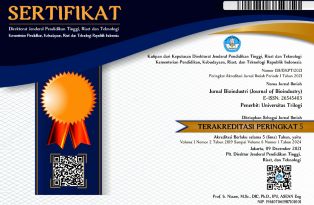PENGARUH KONSENTRASI DAN WAKTU APLIKASI CaCl2 TERHADAP FISIKOKIMIA BUAH TOMAT (Lycopersicum esculentum Mill.)
Abstract
Tomato was classified as a climacteric fruit with a fast ripening period andthen followed by the increase of fruit softening. The inhibition of fruit softening was needed to maintain the quality and shelf life of the fruit. One of the way to inhibit the tomatoes softening was calcium application. However, the best concentration and timing of calcium application for tomato was still limited. The aimed of research was to determine the best combination of concentration and time of application of calcium chloride (CaCl2) to the physicochemical of tomato. Experiment was arranged in factorial completely randomized design (CRD) with two factors and three replications. First factor was concentration of CaCl2 which consisted of 5 levels (0 M; 0.3 M; 0.6 M; 0.9 M; 1.2 M), while the second factor was application time of CaCl2 (pre- and post-harvesting). The results showed that there was no interaction between concentration and application time of CaCl2 to the physicochemical of tomatoes. Treatment of CaCl2 1.2 M could increased fruit calcium content, inhibited weight loss and fruit softness, increased total titrated acid content, and inhibited the degradation of vitamin C. The application time of CaCl2 in pre- and post-harvest was not significantly different in term of physicochemical properties.
Keywords: fruit softness, quality, weight loss, shelf life, vitamin C
Keywords
Full Text:
PDFDOI: https://doi.org/10.31326/jbio.v2i1.481
DOI (PDF): https://doi.org/10.31326/jbio.v2i1.481.g291
Refbacks
- There are currently no refbacks.
Editorial Office:
Fakultas Bioindustri
Universitas Trilogi
Jl. TMP Kalibata No.1
Jakarta 12760
Copyright Notice:


2.png)






2.png)







